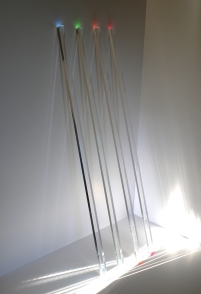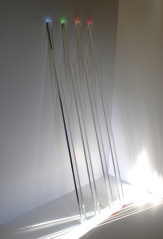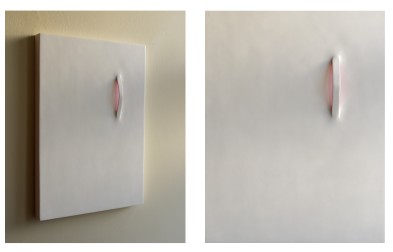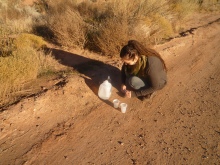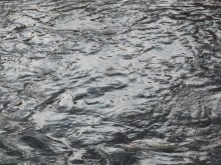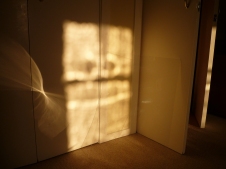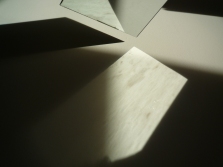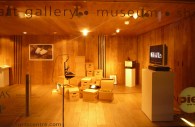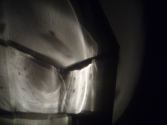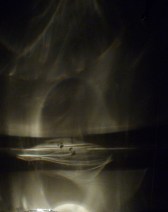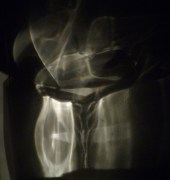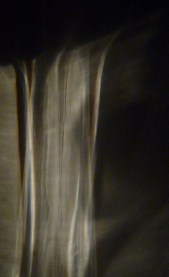09:38:08
June 1, 2012
.
09:38:08
Acrylic bar, fluorescent paint, sunlight
This video piece accompanies the work Untitled (Glow I), developed during an artist residency at the BHF CoRE at the University of Edinburgh, and inspired by the use of light in biomedical research.
Four bars of acrylic lean against a wall with the bottom edge of each bar painted a different shade of fluorescent colour. As sunlight moves across the space and crosses paths with the leaning acrylic, the light is conducted through each bar causing the opposite end to glow. As with Untitled (Glow I), the colours used have been selected in proximity to Roger Tsien’s fluorescent protein palette. As the light activates the painted acrylic, colours of a separated spectrum are revealed. The title of the piece and the moving sunlight also allude to circadian rhythm. Disruption to circadian rhythm in the long term is believed to have adverse health effects, particularly in the development of cardiovascular disease. As in the cyclical and transient process of fluorescence, which is utilised in various techniques and research at the CoRE, the piece relies on the cyclical motion of the sun and is one that reveals itself, much like scientific discovery.
Chandra Casali-Bell
British Heart Foundation CoRE Artist-in-Residence, 2011
Click on image for link to video…
Untitled (Glow) I, 2011
June 1, 2012
.
.
.
.
Untitled (Glow I)
Sanded gesso on board, redwood, fluorescent acrylic
This piece was created in response to the use of light in biomedical research as carried out at the University/BHF Centre for Cardiovascular Science. The integration of optical techniques with molecular strategies has enabled researchers to analyse how single molecules behave within intact cells. Light, colour, fluorescence and luminescence are used to make the invisible visible, to reveal and illuminate.
Untitled (Glow I) consists of four white sculptural panels that are punctuated by a subtle coloured glow. Each colour has been developed to resemble a sample from Roger Tsien’s fluorescent protein palette. Tsien’s multicolored proteins are used to track when and where certain genes are expressed in cells by causing the protein of interest to glow inside the cell. The piece also refers to the various technologies and techniques that expand the use of light as a tool in biomedical research, and where spectral separation is at the core. In fluorescence microscopy, it is essential to separate light with different spectral properties for the excitation of a fluorophore and the detection of its emission. The four panels translate this process of spectral separation and allude to the excitation and emission wavelength spectrum.
The illusory glow effect is further meant to provide subtle visual ambiguities, creating a dichotomy between the way an object initially appears to how it actually exists, and how this relates to scientific objectivity and the subjective nature of our perception.
Chandra Casali-Bell
British Heart Foundation CoRE Artist-in-Residence, 2011
Untitled (Glow II), 2010
June 1, 2012
Untitled (Glow) II Gesso on wood, clear acrylic, fluorescent paint, photo-luminescent pigment
This piece was created in response to the use of light in biomedical research at the Queen’s Medical Research Institute. The piece presents a sculptural interpretation of the research, inspired by discussions with scientists and researchers throughout the residency.
Genetically encoded fluorescent labels derived from jellyfish (GFP) and luciferase, the chemical enzyme that enables fireflies to glow, are utilised by researchers in Molecular Physiology group to explore gene expression and to trace the movement of proteins. The use of reporter genes allows real-time monitoring of gene expression and these “lux genes” have led to significant advances in molecular biology and physiology.
The horizontal panels of clear acrylic allude to technologies such as fluorescence light microscopy and Confocal laser scanning. The latter offers optical sectioning of specimen, providing a three-dimensional reconstruction of an object. With fluorescence microscopy the specimen is illuminated with light of a specific wavelength which is absorbed by fluorophores, such as a green fluorescent protein (GFP), causing them to emit light of a longer wavelength. Each acrylic panel has a painted spine in a gradation of blue, which is reflected onto the front edge of the panel. At select panel corners a red glow is visible, referring to the excitation and emission spectra in light microscopy. The bottom panel contains a sample of photo-luminescent powder so a cyclical process of fluorescence is present in the work.
The piece encourages an active viewing of the work from different perspectives in order to reveal itself. During the day the bottom panel appears as an off-white square but at night the charged luminescent powder will become visible, revealing a floating panel of blue light which fades as its energy is released.
Chandra Casali-Bell
Artist-in-Residence, QMRI 2010
Fieldwork: SW US
July 5, 2011
Comar nan Allt
July 3, 2011
55o 57 N : 03o 58 W | Vacant shop, Cumbernauld Town Centre
Cumbernauld takes its name from the Scots Gaelic comar nan allt meaning ‘the meeting of the waters’ as, geographically, from its high point in the Scottish central belt – streams and rivers flow west to the River Clyde and east to the River Forth – eventually flowing out into the North Channel and North Sea.
Water routes flowing in and around Cumbernauld were traced on a map and seven sources of water were selected which join with the Forth and Clyde rivers. These sites were then travelled to and seven water samples were taken and brought to Cumbernauld where they were displayed in seven glass bowls in a vacant shop window.
River Forth
River Clyde
River Avon
River Carron
Luggie Water
River Kelvin
South Calder Water
Over the course of the exhibition the water gradually evaporated. The water met in the air as it dispersed and vanished, undergoing a state of transformation and causing condensation to appear on the glass window – gradually obscuring the space within.
…
.
.
.
.
Charged Space, 2009
July 2, 2011
Sunlight, photo-luminescent powder
The work occurred on 21 December 2009 and lasted for 24 hours, with the greatest transformations taking place at dawn and dusk.
Winter solstice sunrise/sunset times: 08:42 / 15:40 UT
Location: W003o 13, N55o 57
Sol (sun)
Sistere (to stand still)
The space was charged prior to the solstice by means of a daily ritual:
At sunrise, photo-luminescent powder was raked onto a concrete slab in front of a window
At sunset, the sunlight-infused powder was collected and stored in a kiva which was aligned west of the window.
The powder then re-emitted the sunlight throughout the night, thus ensuring the continual presence of the sun’s light.
After sunset on 21 December, the luminescent powder was permanently stored in the kiva, the light fading – imbued with the winter solstice.
.
.
.
.
.
…
Winter Solstice
July 2, 2011
Winter Solstice Project following fieldwork in Orkney, with the majority of the research taking place on the small island of Hoy. The resulting work was included in a travelling group exhibition in three locations: Edinburgh College of Art, the Pier Arts Center in Stromness and the Royal Academy in Copenhagen.
Influenced by monuments in Orkney’s history that engage with natural light phenomena, such as Maeshowe – a prehistoric cairn with a midwinter alignment – and also with a view to utilise the scarce amount of sunlight at the darkest time of year in the north, this project was a response to the winter solstice which occured on: 21 December 2009, 17:47 U.T
…
Time-based Midwinter Installations
Charged Space, 2009
Hoy3, Pier Arts Centre, Stromness
…
